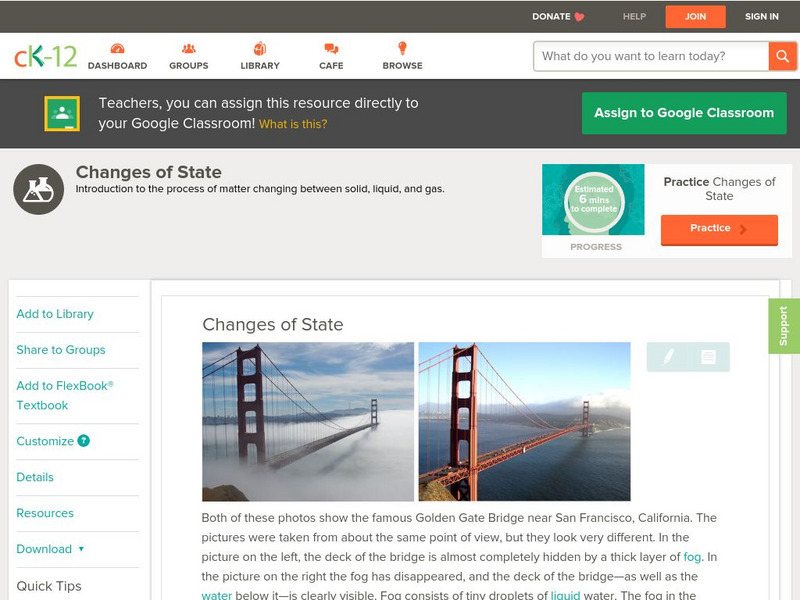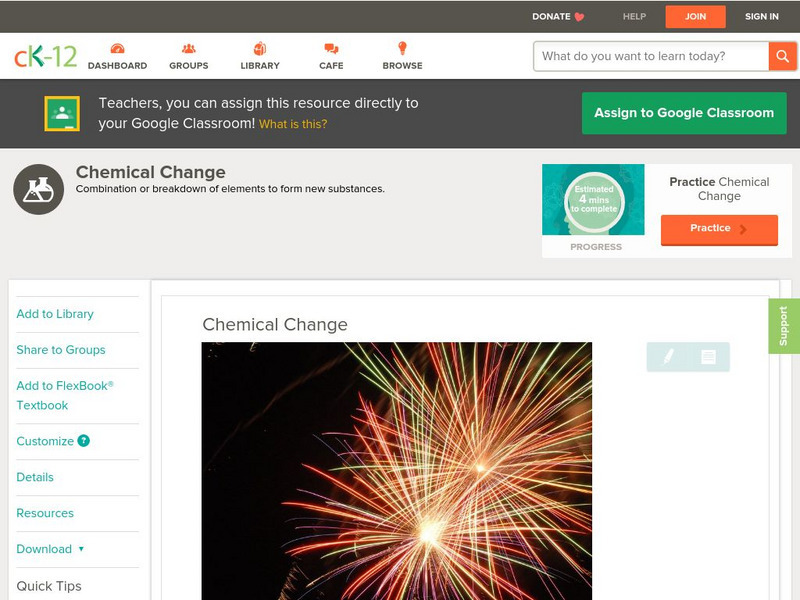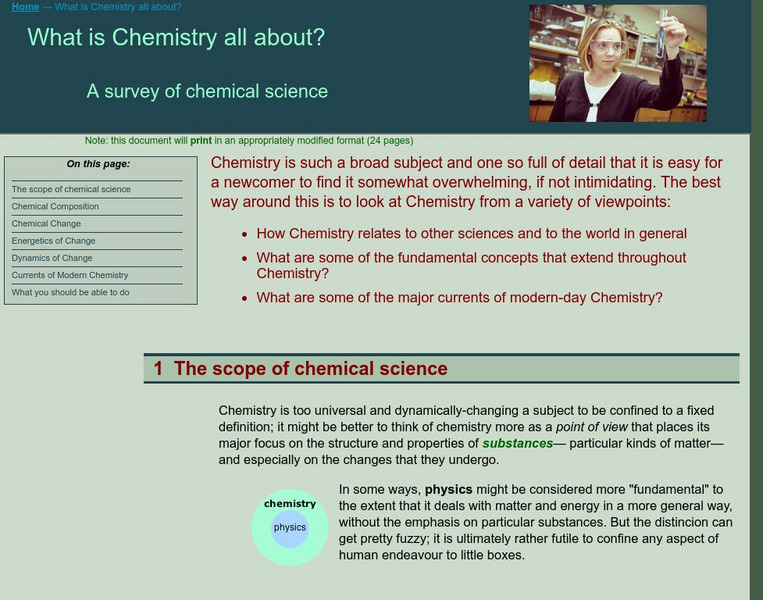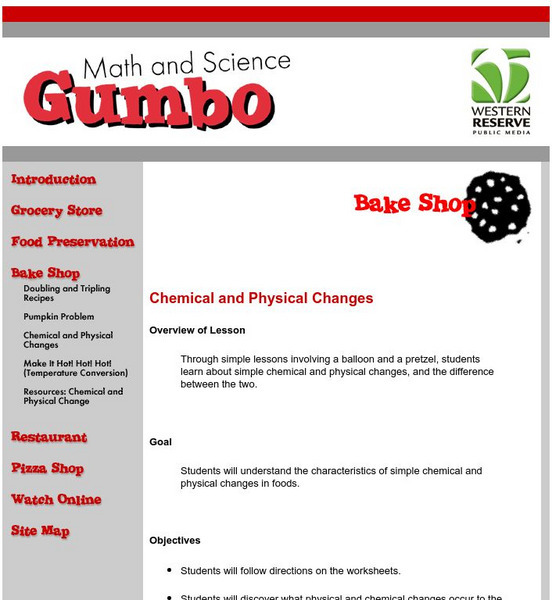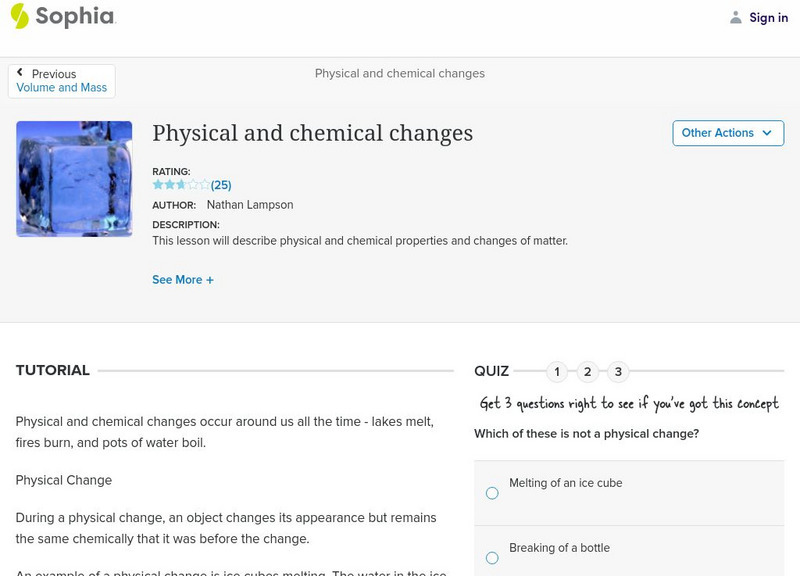Science Struck
Science Struck: Chemical Change Examples That We See Around Us
Explains what a chemical change is and how to identify one. Provides examples of chemical changes that are often seen in organic and inorganic compounds.
Frostburg State University
General Chemistry Online: Ten Signs of Chemical Change
Resource provides the ten signs that tell when a chemical change has occured. Each sign has a detailed explanation.
Frostburg State University
General Chemistry Online: Chemical Change Faq
Investigate the answers to many commonly asked questions about chemical change. This comprehensive list will address chemical equations and double displacement reactions in addition to other topics.
Maryland Science Center
Maryland Science Center: Shrinky Dink Charms [Pdf]
Use recycled plastic to make shrinky dink jewelry and decorations.
ArtsNow
Arts Now Learning: Using Tableau to Explore Physical & Chemical Changes [Pdf]
In this lesson, 5th graders explore how to use tableaux to dramatize physical and chemical changes, and add dialogue to the tableaux to support their argument of whether the change is physical or chemical.
The Wonder of Science
The Wonder of Science: 5 Ps1 4: Mixing Substances
Does mixing two or more substances result in new substances? This site contains work samples, phenomena, assessment templates, and videos that contain content to covers mixing substances.
CK-12 Foundation
Ck 12: Physical Science: Changes of State
[Free Registration/Login may be required to access all resource tools.] Definition of a change of state and the physical processes that cause it.
CK-12 Foundation
Ck 12: Physical Science: Chemical Change
[Free Registration/Login may be required to access all resource tools.] Definition of chemical change and examples, signs of chemical change and how it can be reversed.
E-learning for Kids
E Learning for Kids: Science: Greek Theater: What Are Reversible and Irreversible Changes?
Join Leander in his chemistry lesson, and learn about the change of different types of substances.
CK-12 Foundation
Ck 12: Second Grade Science: Changes
[Free Registration/Login may be required to access all resource tools.] Covers reversible and nonreversible changes.
CK-12 Foundation
Ck 12: Fifth Grade: Physical Science: Physical and Chemical Changes in Matter
[Free Registration/Login may be required to access all resource tools.] Provides the definitions of physical and chemical changes in matter and gives examples. The law of conservation of mass is also described.
CK-12 Foundation
Ck 12: Chemistry Simulation: Camping Chemical and Physical Changes
[Free Registration/Login Required] Explore how heat and temperature relate to phase changes.
Other
Educational Innovations: Diaper Polymer Activities [Pdf]
What can you do with diaper polymer? Check out these six quick student experiments involving the chemical used in diapers.
Alabama Learning Exchange
Alex: Name That Change!
This lesson teaches students to distinguish between physical and chemical changes. Students will view an interactive slideshow presentation and then conduct experiments to discern physical and chemical changes.
Utah Education Network
Uen: Hot and Cold
Students study the energy associated with physical and chemical changes. The activity consists of observing nine phenomena.
Science and Mathematics Initiative for Learning Enhancement (SMILE)
Smile: Somethin' Sweet
This site provides a lesson plan using candy making to demonstrate physical and chemical changes in matter. Includes directions to make caramel and rock candy.
Simon Fraser University
Chem1 Virtual Textbook: Chemical Change
Chemical change is a section of a larger overview on Chemistry, covering a variety of aspects. This section focuses on chemical change including the difference between chemical change and physical change.
Other
The Science House: Dancing Spaghetti
The chemical change of matter is illustrated in this lab experiment when spaghetti is placed in a solution of baking soda and vinegar. Watch the spaghetti rise to the surface and sink again once the gas is released.
Other
The Science House: Combustion
In this experiment, students will observe that the weight of the product of combustion is greater than that of the starting material. Teacher's notes address the key concepts of this experiment.
Other
The Science House: Ziptop Bag Chemistry
In this experiment, three reactions are performed in a sealed Ziploc bag so that they can be observed. Students identify whether physical or chemical change has taken place.
Other
Western Reserve Public Media: Math & Science Gumbo: Bake Shop
In these two lessons, students use pretzels and balloons to learn about reversible and non-reversible physical and chemical changes.
Sophia Learning
Sophia: Physical and Chemical Changes
This lesson will describe physical and chemical properties and changes of matter.
ClassFlow
Class Flow: Physical and Chemical Changes
[Free Registration/Login Required] This flipchart introduces fifth graders to physical and chemical changes in matter. The Law of Conservation of Matter is also covered.
ClassFlow
Class Flow: Physical and Chemical Changes
[Free Registration/Login Required] Physical and chemical changes are defined and examples are given of each. Practice with determining the difference between mixtures and solutions are also given. Links to external sites for practice...






